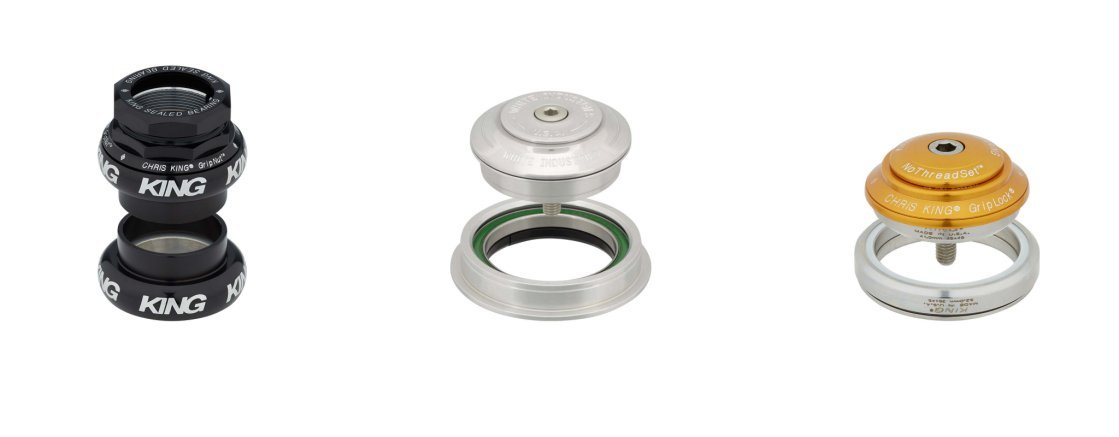
Bicycle inner tubes for road bikes or MTBs: Wha...
Bicycle tube or tubeless tyre? Butyl, TPU or latex? Find out which system is best for you and your bike here.
You can easily find the right headset for your bike with the help of S.H.I.S. We’ll explain how this standardised naming system works.
Whether you’re choosing components for your new custom road bike or want to change the headset on your mountain bike, the multitude of available designs can seem a little daunting at first glance. Don't worry: the abbreviations and numbers in the item designations of headsets adhere to a standardised system that is logically structured and very helpful. The system is known as S.H.I.S. (Standardised Headset Identification System) and was introduced jointly by several manufacturers in 2010. It describes headsets of the Ahead design; older bolt-on headsets a with clamping stem are not considered. We explain here how the standardised S.H.I.S. designation is structured, what the letters and numbers mean and what measurements you need to find the right headset for your project.
Each S.H.I.S. specification consists of three parameters of the headset: design, outer diameter and inner diameter. In addition to its function as a handlebar bearing, the headset also serves as an interface between the frame and the fork. These are available in different dimensions, which results in a number of combinations. S.H.I.S. takes into account both the head tube of your frame and the diameter of your steerer tube. An example of the standardised specification looks like this: ZS44/28.6 - EC44/40. The first two letters of an S.H.I.S. indication stand for the design of the headset. We will explain exactly what they mean in a moment. The two numbers after that represent the inner and outer diameters in millimetres. Since a headset always consists of two parts, the standardised designation is also made up of two parts with the same structure. The first half stands for the upper cup (between stem and frame) and the second half for the lower cup (between frame and fork). Our shop also supplies many upper and lower cups separately. Not only can you put together unusual combinations and mix colours, for example, but in the event of a defect, you only have to replace the worn-out part, which helps you save on costs.
S.H.I.S. indicates the headset design, the outer and inner diameter. That's all you need to consider when choosing your headset. © bc GmbH
In many cases, it is easier to take a look at the data sheets before you measure your fork and frame yourself. Installation dimensions for headsets are usually noted there. If you do not find any values, you can easily determine the decisive outer and inner diameters with a caliper gauge. We’ll explain below where exactly you should measure. Unfortunately, you cannot measure a headset design, but there are only three different variants that are relatively easy to distinguish. Once you have all the values, our shop offers you two ways to find suitable headsets: You can set the parameters as filters and thus gradually narrow down the selection, or you can combine them according to the S.H.I.S. nomenclature and enter them in the search bar.

There are three types of headsets: external cup, zero stack & integrated systems. © bc GmbH
External Cup is the classic headset design. The bearing cups are pressed into the frame and the wider part remains outside the head tube of the frame (hence "external"). The actual bearings are located in the outer parts of the bearing cups. An example is the classic 1-1/8 inch headset: EC34/28.6 – EC34/30.
With the zero stack headset, a large part of the bearing cup is pressed into the frame. When assembled, only a narrow collar on each shell is visible outside of the head tube. The bearings thus also disappear into the frame, which is why the head tubes usually have a larger diameter. The advantage here is the low overall height (hence "zero stack"). Using the shop filter "Design" will show you zero stack headsets. A typical example of a zero stack tapered headset for a modern bike, such as the RAAW Madonna, is: ZS44/28.6 - ZS56/40.
IS headsets: Integrated Systems
With completely integrated headsets, the bearings are located directly in the frame without an extra bearing cup. The head tube has a precisely manufactured crown race seat. Santa Cruz, for example, relies relatively often on this type of design. For example, a common measurement for tapered headset in carbon frames is: IS42/28.6 - IS52/40.
The abbreviation of the headset type is followed by the outer diameter in millimetres in the S.H.I.S. specification. The dimension refers to the part of the headset that is pressed into the frame – for EC and ZS the bearing cup, for IS the bearing itself. The lower bearing cup on frames for tapered forks usually has a larger press-in diameter than the upper one. If you cannot find the required measurements in the data sheet of your frame or bicycle, you can attain them relatively easily with a caliper gauge. To do this, measure either the inner diameter of the head tube of your frame (without the headset fitted) or the outer diameter of the old headset that has already been removed.
You can determine the required outer diameter of the headset by measuring the inner diameter of your head tube. © bc GmbH
S.H.I.S. denotes the inner diameter of the headset after the slash. Your fork dictates what fits at that point – the diameter of the steerer tube, to be precise. If you are unsure, you can simply measure it using the caliper. You determine the first value in the upper part – about where your stem will be clamped later. Measure the second value directly above the fork crown. There is the crown race seat, which is always slightly thicker than the rest of the steerer tube. The difference is even greater with tapered forks. The lower cup of the headset here has a significantly larger inner diameter. Two different types of fork stems currently dominate the market:
• Tapered (1 1/8 to 1.5 inch) with 28.6 millimetres at the top and 40 millimetres at the crown
• Continuous 1 1/8 inch with 28.6 millimetres at the top and 30 millimetres at the crown race
By the way, with a reducer crown you can also install a fork with a continuous 1-1/8 inch steerer tube in a tapered headset.
Finally, let's take the example from the beginning and flesh it out in detail. You could use a headset with the specification ZS44/28.6 - EC44/40 in a 29-inch hardtail bc original Podsol with a tapered fork. The parameters and dimensions in millimetres in order:
| Parameters / Dimensions | Explanation |
| ZS | the upper bearing cup is semi-integrated, i.e. Zero Stack |
| 44 | the press-in diameter of the upper bearing cup (also corresponds to the inner diameter of the head tube) |
| 28.6 | the inner diameter of the upper headset cup (suitable for a 1 1/8 inch or a tapered fork) |
| EC | the lower bearing cup is an external one, i.e. External Cup |
| 44 | the press-in diameter of the lower bearing cup (also corresponds to the inner diameter of the head tube) |
| 40 | the crown race seat of the steerer tube, directly above the fork crown |